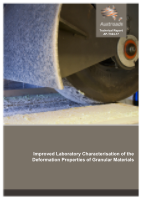Pavement

- Publication no: AP-T324-17
- ISBN: 978-1-925451-99-3
- Published: 8 August 2017
- PDF (free) Download
This report examines the capacity of the extra-large wheel-tracking laboratory test method to predict the in-service performance of granular materials.
Rutting is a common distress mode of unbound granular bases under thin bituminous surfacings.
Five granular bases were tested for rut-resistance under accelerated loading and the results compared to a number of laboratory characterisation tests. The laboratory tests included large-scale wheel tracking, repeat load triaxial and shear strength.
It was concluded that the large-scale wheel-tracking test was the best available test to rank granular base rut-resistance. It is a useful performance-based test, which can lead to significant cost saving by optimising the use of otherwise non-traditional locally available aggregate resources.
- Summary
- 1. Introduction
- 1.1. Background
- 1.2. Project Objective and Outline
- 1.3. Report Outline
- 2. Findings of Previous Wheel-tracking and RLT Testing Research
- 2.1. Introduction
- 2.2. Austroads RLT Findings
- 2.3. Findings of Wheel-tracking Testing
- 3. Properties of Materials Selected for Evaluation
- 3.1. General
- 3.2. Results of Basic Characterisation Testing
- 4. Full-scale Accelerated Loading Program
- 4.1. Introduction
- 4.2. Pavement Composition
- 4.3. Loading Conditions
- 4.4. Test Pavement Layout
- 4.5. Experiments
- 4.6. As-constructed Pavement Conditions
- 4.7. Moisture Control and Management
- 4.7.1. Increase in Moisture Content
- 4.8. Pavement Condition Data
- 4.8.1. Surface Deflection
- 4.8.2. Moisture Content
- 4.8.3. Dry Density
- 4.8.4. Surface Deformation
- 5. Performance During Accelerated Loading
- 5.1. Introduction
- 5.2. Uniformity of Test Sections
- 5.3. Analysis of Deformation Data
- 5.3.1. Adjustment for Bedding-in
- 5.3.2. Prediction Model
- 5.3.3. Results
- 5.4. Effect of Moisture Content on Performance
- 5.4.1. Deformation-moisture Prediction Models
- 5.4.2. Comparison of Performance (10 mm Deformation)
- 5.4.3. Comparison of Performance (Deformation after 200 000 Passes)
- 5.5. Summary
- 6. Evaluation of Laboratory Wheel-Tracking Test
- 6.1. Introduction
- 6.2. Summary of the Wheel-tracking Method
- 6.2.1. Terminology
- 6.2.2. Specimen Preparation
- 6.2.3. Test Method
- 6.2.4. Achieved Specimen Properties
- 6.3. Performance Parameters and Analysis
- 6.3.1. Laboratory Wheel-tracking Performance Analysis
- 6.3.2. Wheel-tracking Deformation Model
- 6.4. Results of Laboratory Wheel-tracking Testing
- 6.4.1. Testing Program
- 6.4.2. Wheel-tracking Results
- 6.5. Effect of Moisture on Deformation Under Wheel Tracking
- 6.5.1. Moisture Sensitivity Model
- 6.5.2. Influence of Measured Density on Performance
- 6.5.3. Comparison of Material Performance
- 6.5.4. Comparison of Surface Deformation for Given Number of Cycles
- 6.5.5. Effect of Degree of Saturation
- 6.6. Performance Ranking from the Wheel-tracking Test Compared to Accelerated Loading
- 7. Evaluation of Austroads Repeated Load Triaxial (RLT) Test
- 7.1. Introduction
- 7.2. Testing Conditions
- 7.3. Test Densities and Moisture Contents
- 7.4. Results
- 7.5. Effect of Moisture Content on Permanent Deformation
- 7.6. Ranking of Performance
- 7.7. Comparison of Ranking from Austroads RLT Test and Accelerated Loading
- 8. Evaluation of the TMR Repeated Load Triaxial Test
- 8.1. Test Method
- 8.2. Test Densities and Moisture Contents
- 8.3. Results
- 8.4. Ranking of Performance: TMR RLT Test Compared to Accelerated Loading
- 9. Evaluation of Static Shear Strength Test
- 9.1. Introduction
- 9.2. Pavement Stress Analysis
- 9.3. Test Method
- 9.4. Results
- 9.5. Effect of Moisture Content on Performance
- 9.6. Comparison of Shear Strength Results with Performance under Accelerated Loading
- 10. Conclusions
- References
- Appendix A Summary of Data Obtained in Accelerated Loading Experiments
- Appendix B Deformation Prediction Models Calculated from Accelerated Loading Data
- Appendix C Moisture Sensitivity Models Fitted to Accelerated Loading Data
- Appendix D Laboratory Wheel-tracking Density Data
- Appendix E Laboratory Wheel-Track Deformation Prediction Model
- Appendix F Laboratory Wheel-tracking Performance
- F.1 Cycles to 10 mm Deformation
- F.2 Effect of Deformation Level on Performance Ranking
- F.3 Moisture Sensitivity Including Extra Data
- F.4 Level of Deformation at Different Cycle Numbers
- F.5 Performance Ranking Based on Rut Depth
- Appendix G TMR Repeat Load Triaxial Testing
- G.1 Introduction
- G.2 Summary of TMR Test Method
- G.3 Maximum Dry Density and Optimum Moisture Content
- G.4 Results of RLT testing
- G.4.1 Test Densities and Moisture Contents
- G.5 Permanent Deformation Results
- Appendix H Shear Strength Testing Results
